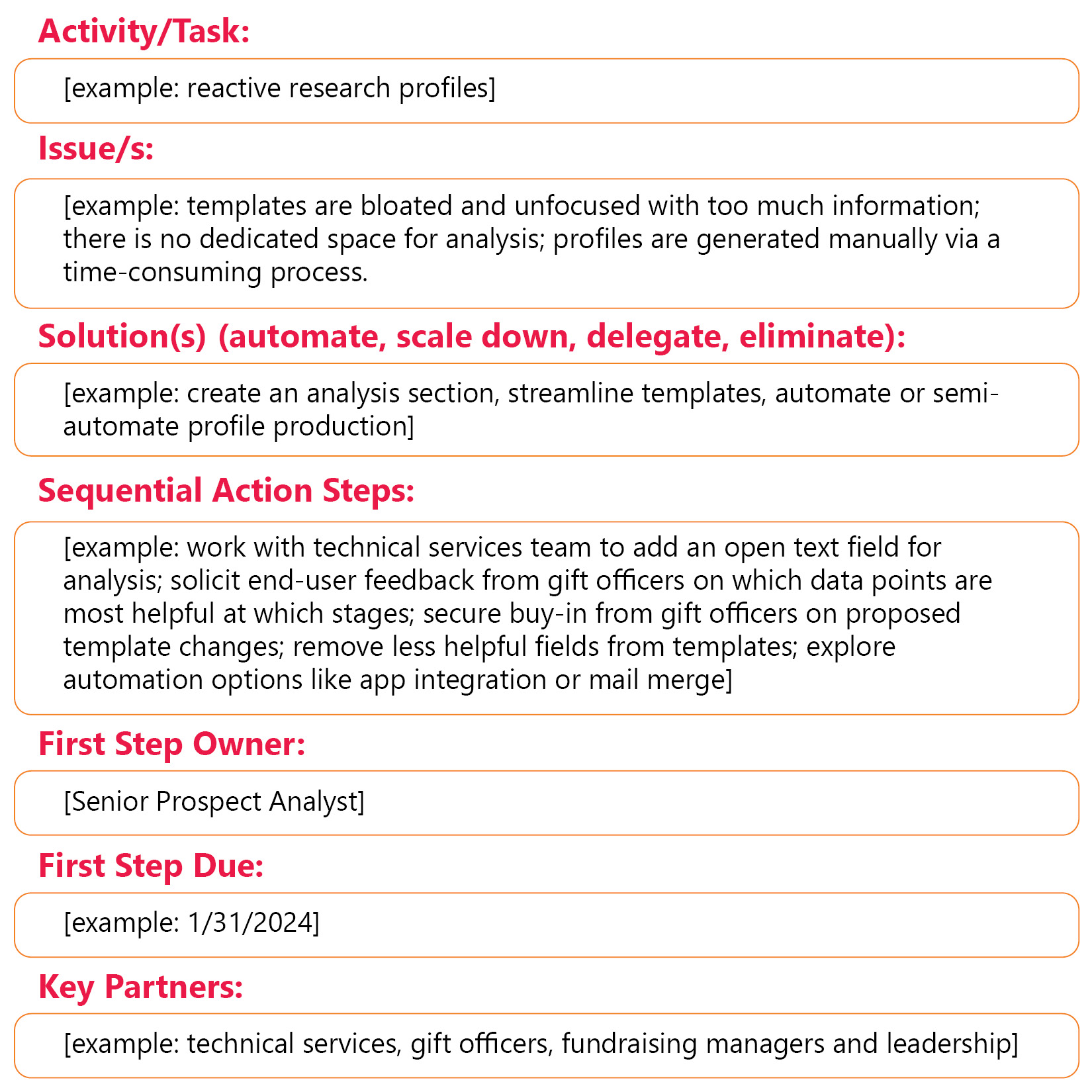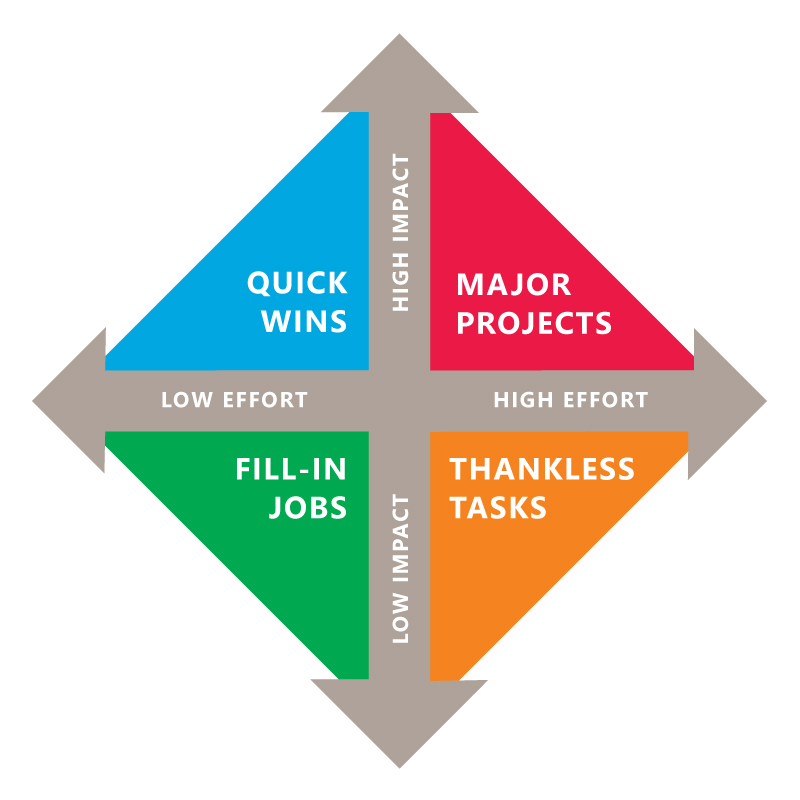Many prospect development offices struggle with unmanageable workloads.
However, by focusing on the primary goal, prioritizing the highest-impact work that leverages prospect development’s unique skills, and carefully planning implementation, more bandwidth can be created, increased value can be generated, and scope creep can be minimized.
Prospect development often takes the position of “mission control” within the organization:
- Monitoring, connecting, and analyzing intelligence from a variety of sources
- Translating raw data into user-friendly insights
- Anticipating questions from leadership and frontline fundraisers
- Proactively communicating actionable intelligence
- Making strategic recommendations
We normally think of this positioning as a positive. However, when functioning as a liaison among many different, yet intersecting, offices—leadership and management, frontline fundraisers, constituent records and gift processing, etc.—we sometimes get overloaded with tasks that are:
- Out of scope (e.g., updating contact information from returned direct mail).
- Tactical rather than strategic (e.g., compiling public biographies for dozens of event attendees or refreshing profiles for constituents already well known to the organization).
- Manual and time-consuming (e.g., copying and pasting field after field from the database into a profile document).
These tasks have a way of creeping up on us over time. Before we know it, what started as a one-time favor is now a regular chore that has somehow become our responsibility. Even when we know we shouldn’t, there are many justifications we tell ourselves for continuing with inappropriately scoped workloads:
- “It would take me longer to teach someone else how to do this than if I just did it myself.”
- “I don’t think so-and-so will do as good a job as I will.”
- “That other office is really busy.”
- “Leadership asked for this, so I have to do it this way.”
- “I want to be helpful/be a team player.”
- “Pushing back might damage my relationships.”
While some of these statements may have a small degree of truth to them, prospect development’s impact is blunted when we accept work that belongs to other offices, does not leverage our unique skills, and/or provides comparatively little benefit for the effort expended.
However, there are ways to rescope workload that will help.
Focus
First, focus your goal: Define your team’s purpose as simply and clearly as possible. For example, you might say your prospect development office’s mission is to provide gift officers and leadership with actionable prospect intelligence that drives major and principal gift fundraising success.
Then, list out your functions and tasks, being as specific as possible. For each one, ask yourself, “Is it necessary for us to do this in order to fulfill our purpose?” (The “us” part is key—the task may be needed, but the prospect development team’s ownership of it may not be.) If the answer is no, cross it off. Once you have gone through the entire list, repeat the exercise again (and again, if needed) with the remaining activities. Be ruthless! Your goal is to whittle down your list to the core tasks—about 4-6 in total—that are inarguably required of your team to fulfill its purpose. This is the foundation of your rescoping plan.
Prioritize
Next, review the items you crossed out to see which ones truly leverage prospect development’s unique skills versus those that can be performed by other offices, including administrative staff. For the latter tasks, determine which office is the appropriate owner for each and secure buy-in to begin redirecting requests to them.
For the remaining items, consider how you might scale down, automate, delegate, or eliminate these functions and whose support or permission you would need. One helpful framework to guide this exercise is an impact/effort matrix:
- Quick Wins should be prioritized to demonstrate value, build momentum, and increase confidence.
- Major Projects are worthwhile but take extra time and resources, so don’t tackle too many of these projects at one time and consider whether any elements could be scaled down to reduce effort.
- Fill-in Jobs, performed as bandwidth allows, are often prime opportunities for automation and sometimes delegation.
- Thankless Tasks should be scaled down, automated, or eliminated whenever possible to minimize the drain on resources.
Plan
The exercises above may produce a bevy of issues that your team will need to solve. The first step is identifying factors that are likely to support successful change. One approach is through storytelling. Divide your team into pairs and ask each person to tell the other about a time they collaborated with others on an effective project, noting any conditions that made the success possible. Depending on the size of your team, put the pairs into groups of four or bring the entire group back together and have each person retell their partner’s story. As a team, list out all the success factors they observed and encourage reflection on insights and patterns.
Next, starting with the most urgent, brainstorm possible solutions that fit each issue’s impact-effort quadrant, and then draw from the success factors to select the best one(s) to move forward. A worksheet like the following may be helpful:

Conclusion
Inappropriate scope and unsustainable workloads are common challenges faced by our field. Excuses for scope creep abound, and it’s undeniably challenging to reverse course once the precedent has been established. However, by focusing, prioritizing, and planning, we can help ensure more of our time is spent on high-value tasks that produce a strong return on investment.
BWF has partnered with prospect development teams across the industry to rescope their workloads by leveraging these and other creative techniques. To learn more about how to combat scope creep and grow your prospect development team’s impact, please reach out to Catherine Flaatten at cflaatten@bwf.com.





